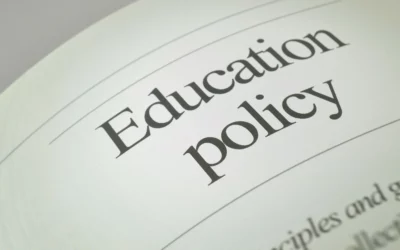
Written by Christine Cooke Fairbanks
January 25, 2024

According to Utah Gov. Spencer Cox’s recent State of the State address, one of Utah’s most fascinating national rankings is the one showing that Utahns reject zero-sum thinking more than any other state in the country.
That attribute can apply even in education choice – a topic usually framed as being in conflict with public schools. Choice policies do not have to be at odds with the public school system, but rather can be a feature within it.
Former Idaho state Sen. Steven Thayn believes in education choice policies that also alleviate concerns about public school funding. Specifically, he thinks there is a future for microschool partnerships with public school districts.
I dug a little deeper to learn more from Thayn about microschool partnerships, an innovation under the umbrella of education choice.
Christine Fairbanks: You recently wrote an article that was published by the American Enterprise Institute called “Promoting Microschool Partnerships.” What is a microschool partnership? And how is it different from other microschool options?
Thayn: This partnership is between the local school district and a single family or a group of families.
The main purpose of this microschool approach is to let parents choose the curriculum without process oversight by the state.
The accountability is injected into the system by checking results, not by regulating how the microschool is run. Parents get to choose the curriculum, length of school day, and the instructor, who need not be certified.
Most microschools do not have access to public funding; this proposal changes that.
The main concern parents have with the current public schools is curriculum. Many parents want pro-American, traditional instruction. This proposal solves this problem by letting parents choose any curriculum they want with or without a religious worldview. Parents can tap into any excellent curriculum, including home-school curriculum.
Fairbanks: Since microschool partnerships rely on a continued relationship between families and public schools, do microschooling families in either the sponsorship or outcome-based funding (OBF) model have access to school resources like curriculum, extracurricular activities, or sports?
Thayn: Yes, for extracurricular activities and sports. Taking classes from the local school district could be negotiated at the creation of the microschool. Under the multifamily microschool, each parent may receive up to $4,000 per year, which could be used to purchase specific classes from the school district. This proposal only covers grades kindergarten through the 8th grade.
Fairbanks: These options still require that students perform well on state tests and/or provide weekly examples to their sponsoring school district because they are receiving state funds. What does curricular freedom look like here? Could it include religiously based curriculum?
Thayn: The parent in the parents-as-teachers model or parents in the multifamily microschool may choose any curriculum they want. The bill states “parents may choose a curriculum without or without a religious worldview.” Students must take and pass a state test at a level equal to or better than the average student in Idaho in the subjects of English and math. As long as the students do well in these two subjects, the parents can teach other subjects. The purpose of the test is to see if the students are learning the state content standards. This should be the only concern of legislators and taxpayers. The path the parents choose to achieve this goal should not be regulated by the state.
A math or English curriculum that has a Christian or other religious worldview would also be allowed. One of the overarching concerns parents have of public education is its humanistic, anti-Christian focus. Parents concerned about this issue can reverse this trend for their own children in their own microschool.
Fairbanks: What sort of response has there been from public schools in Idaho so far? Would this address rural school district concerns about losing funding when students look for choice options?
Thayn: The bill is supported by two charter school systems that have a statewide presence with about 16,000 students between them. In speaking with the head of the state administrators’ association, he does not see any red flags. It is still early in the process to give more detail.
This bill addresses most concerns rural school districts have about losing funds. They either keep them all under that parents-as-teacher model, giving back to the parents around $1,700 per year, or keep 40% of the funds under that performance-based microschool with multiple families. This second model allows them to shed teacher, transportation, and special education costs under the multifamily microschool.
Fairbanks: Why might a state that has already passed education savings accounts, like Utah, still be interested in a policy like microschool partnerships?
Thayn: There are several reasons. I will mention just four. I want to clarify that microschools and ESAs should not be seen as an either/or choice; both have value.
First, a microschool setting for many struggling students may be the best educational setting because they can get immediate, one-on-one attention. I have seven middle school boys in my microschool, and all say they learned more math in two months than they did all of last year.
Second, this bill would immediately open up school choice to thousands of additional parents with no negative fiscal impact to taxpayers. This is because microschools have low startup costs. Microschools can be housed in dance studios, libraries, homes, churches and many other places. No new schools are needed.
Third, the highest form of school choice is parents choosing the curriculum. This microschool approach gives parents total control over the curriculum.
Fourth, because these microschools are sponsored by the local school district, the voice of microschool parents still rings in the traditional school structure. Under ESAs, the most engaged parents’ voices are lost because they leave the system.
Conclusion
During the 2023 legislative session, Utah passed a universal education savings account – a policy considered to be the gold standard among many education choice proponents. Still, education choice ought to be seen as a panoply of approaches, especially when some policies might address multiple concerns.
For policymakers who want to balance the principle of choice for parents while also offering public schools a way to compete, this policy is worth investigating. Certainly, the approach fits within Utah’s model of win-win policy solutions.

Insights: analysis, research, and informed commentary from Sutherland experts. For elected officials and public policy professionals.

- Microschool partnerships are a new education choice model that lets families partner with the public district.
- With microschool partnerships, the public system retains much of the money for the student enrolled while giving families full freedom of curriculum.
- Accountability comes with reviewing results rather than regulating how families teach or structure the learning.
Read More
Education policy to consider during the 2024 election season
Here’s a look at what each presidential candidate is likely to focus on in education, given their track records and campaign platforms.
Ignoring the text of the Constitution is a mistake
A written Constitution is entirely superfluous if the document is simply meant to give the people what they want.
What you need to know about election integrity
It should be easy to vote and hard to cheat. This oft-quoted phrase has been articulated as a guiding principle by many elected officials wading into voting and election policy debates in recent years. So why has this issue been so contentious, and what’s the solution?


